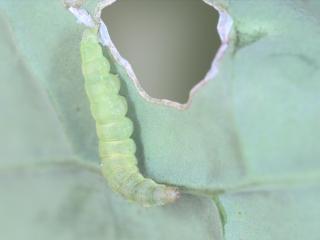Are you checking for diamondback moth caterpillars in your canola crops?
- Mullewa
Nick McKenna (Planfarm) has reported finding low numbers (4 per 10 sweeps) of diamondback moth (DBM) caterpillars in a canola crop near Mullewa.
Growers and consultants are advised to monitor for DBM caterpillars, especially from August onwards, by doing at least four lots of 10 sweeps with an insect sweep net at various locations in canola crops. Past GRDC funded department research into DBM outbreaks has indicated that July to August is a critical time of year to monitor caterpillar numbers as it assists with foreseeing possible damaging spring populations.
As temperatures increase in Spring, the life-cycle of DBM is shorter and numbers usually build up in this time. Their short life cycle means that all life stages are often present in the crop (moth, egg, caterpillar and pupa).
DBM are difficult to control as they are resistant to many insecticide and insecticide sprays have limited coverage in advanced canola canopies. Eggs can hatch soon after a spray and damage unsprayed leaf regions and build up the populations further, which is why a two-spray strategy (one week apart) is the most effective strategy in breaking the life cycle to reduce populations as much as possible.
Brassica weeds (for example, wild radish) and volunteer canola present prior to sowing forms a green bridge and can often ramp up populations prior to spring when they are usually causing damage to crops. Cold winter weather will hinder their reproduction and spread to some extent, but populations of DBM present in crops can reproduce rapidly and unpredictably so monitoring is recommended.
Thresholds for control are:
- Pre-flowering (stressed crop) - 30 or more grubs per 10 sweeps
- Pre-flowering (no stress) - 50 or more grubs per 10 sweeps.
DBM caterpillars drop from plants when disturbed and bashing some plants, especially those with holes in leaves, over an ice cream container is a good initial indication of their presence if you don’t have a sweep net handy.
The PestFax team is keen to be notified of any DBM activity in WA to improve our field surveillance so that growers and consultants can be notified of increased risk. PestFax also encourages monitoring for DBM so that this pest is managed at the right time. You can make reports via the PestFax Reporter app.
For more DBM information refer to:
- DPIRD’s Diagnosing diamondback moth page
- GRDC's Diamondback moth fact sheet
- GRDC’s Managing diamondback moth video.
For more insect information contact Dustin Severtson, Development Officer, Northam on +61 (0)8 9690 2160 or Alan Lord, Technical Officer, South Perth on +61 (0)8 9368 3758 or Svetlana Micic, Research Officer, Albany on +61 (0)8 9892 8591.
Article authors: Cindy Webster (DPIRD Narrogin), Dusty Severtson (DPIRD Northam), Alan Lord (DPIRD South Perth), Svetlana Micic (DPIRD Albany).

